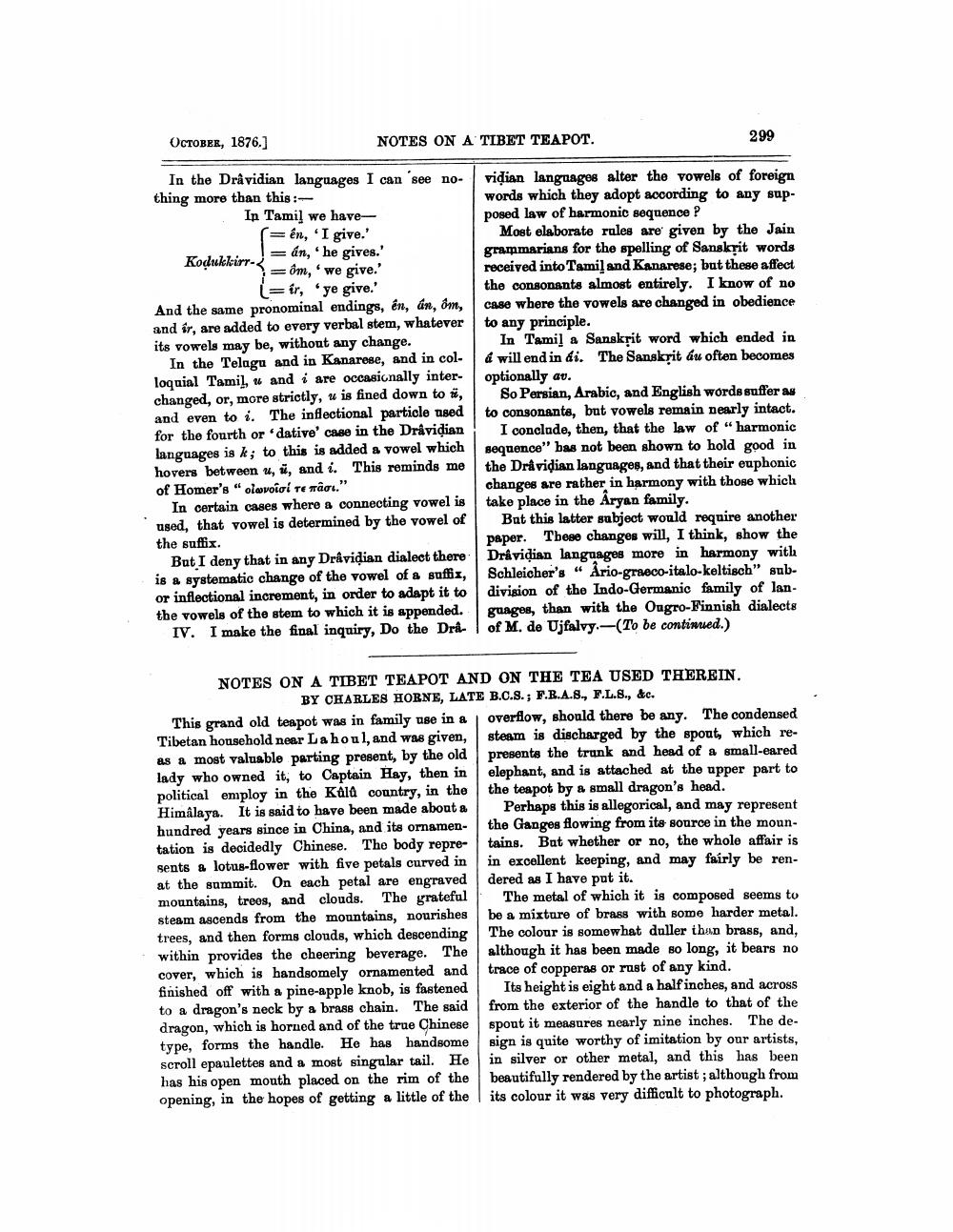________________
OCTOBER, 1876.]
NOTES ON A TIBET TEAPOT.
299
In the Dravidian languages I can see no. thing more than this:--
In Tamil we have
= én, 'I give.' Kodukkirr
= án, he gives.'
ôm, we give.”
(=ir,'ye give.' And the same pronominal endings, én, án, ôm, and ir, are added to every verbal stem, whatever its vowels may be, without any change.
In the Telugu and in Kanarese, and in col- loquial Tamil, 1 and i are occasionally interchanged, or, more strictly, u is fined down to ti, and even to i. The inflectional particle used for the fourth or dative case in the Dravidian languages is k; to this is added a vowel which hovers between u, a, and i. This reminds me of Homer's "olovoioi te mão."
In certain cases where a connecting vowel is used, that vowel is determined by the vowel of the suffix.
But I deny that in any Dravidian dialect there is & systematic change of the vowel of a suflix, or inflectional increment, in order to adapt it to the vowels of the stem to which it is appended.
IV. I make the final inquiry, Do the Dri-
viļian languages alter the vowels of foreign words which they adopt according to any supposed law of harmonic sequence ?
Most elaborate rules are given by the Jain grammarians for the spelling of Sanskrit words received into Tamil and Kanarese; but these affect the consonants almost entirely. I know of no case where the vowels are changed in obedience to any principle.
In Tamil a Sanskrit word which ended in & will end in di. The Sanskrit ku often becomes optionally av.
So Persian, Arabic, and English words suffer as to consonants, but vowels remain nearly intact.
I conclude, then, that the law of "harmonic sequence" bas not been shown to hold good in the Dravidian languages, and that their euphonic changes are rather in harmony with those which take place in the Aryan family.
Bat this latter subject would require another paper. These changes will, I think, show the Dravidian languages more in harmony with Schleicher's “ Ario-graeco-italo-keltisch" subdivision of the Indo-Germanic family of languages, than with the Oagro-Finnish dialects of M. de Ujfalvy. (To be continued.)
NOTES ON A TIBET TEAPOT AND ON THE TEA USED THEREIN.
BY CHARLES HORNE, LATE B.C.S.; F.R.A.B., F.L.B., &c. This grand old teapot was in family use in a overflow, should there be any. The condensed Tibetan household near La houl, and was given, steam is discharged by the spout, which reas a most valuable parting present, by the old presents the trunk and head of a small-eared lady who owned it, to Captain Hay, then in elephant, and is attached at the upper part to political employ in the Kald country, in the the teapot by a small dragon's head. Himalaya. It is said to have been made about a Perhaps this is allegorical, and may represent hundred years since in China, and its ornamen- the Ganges flowing from its source in the mountation is decidedly Chinese. The body repre- tains. But whether or no, the whole affair is sents a lotus flower with five petals curved in in excellent keeping, and may fairly be renat the summit. On each petal are engraved dered as I have put it. mountains, treos, and clouds. The grateful The metal of which it is composed seems to steam ascends from the mountains, nourishes be a mixture of brass with some harder metal. trees, and then forms clouds, which descending The colour is somewhat duller than brass, and, within provides the cheering beverage. The although it has been made so long, it bears no cover, which is handsomely ornamented and trace of copperas or rust of any kind. finished off with a pine-apple knob, is fastened Its height is eight and a half inches, and across to a dragon's neck by a brass chain. The said from the exterior of the handle to that of the dragon, which is horned and of the true Chinese spout it measures nearly nine inches. The detype, forms the handle. He has handsome sign is quite worthy of imitation by our artists, scroll epaulettes and a most singular tail. He in silver or other metal, and this has been has his open mouth placed on the rim of the beautifully rendered by the artist; although from opening, in the hopes of getting a little of the its colour it was very difficult to photograph.




